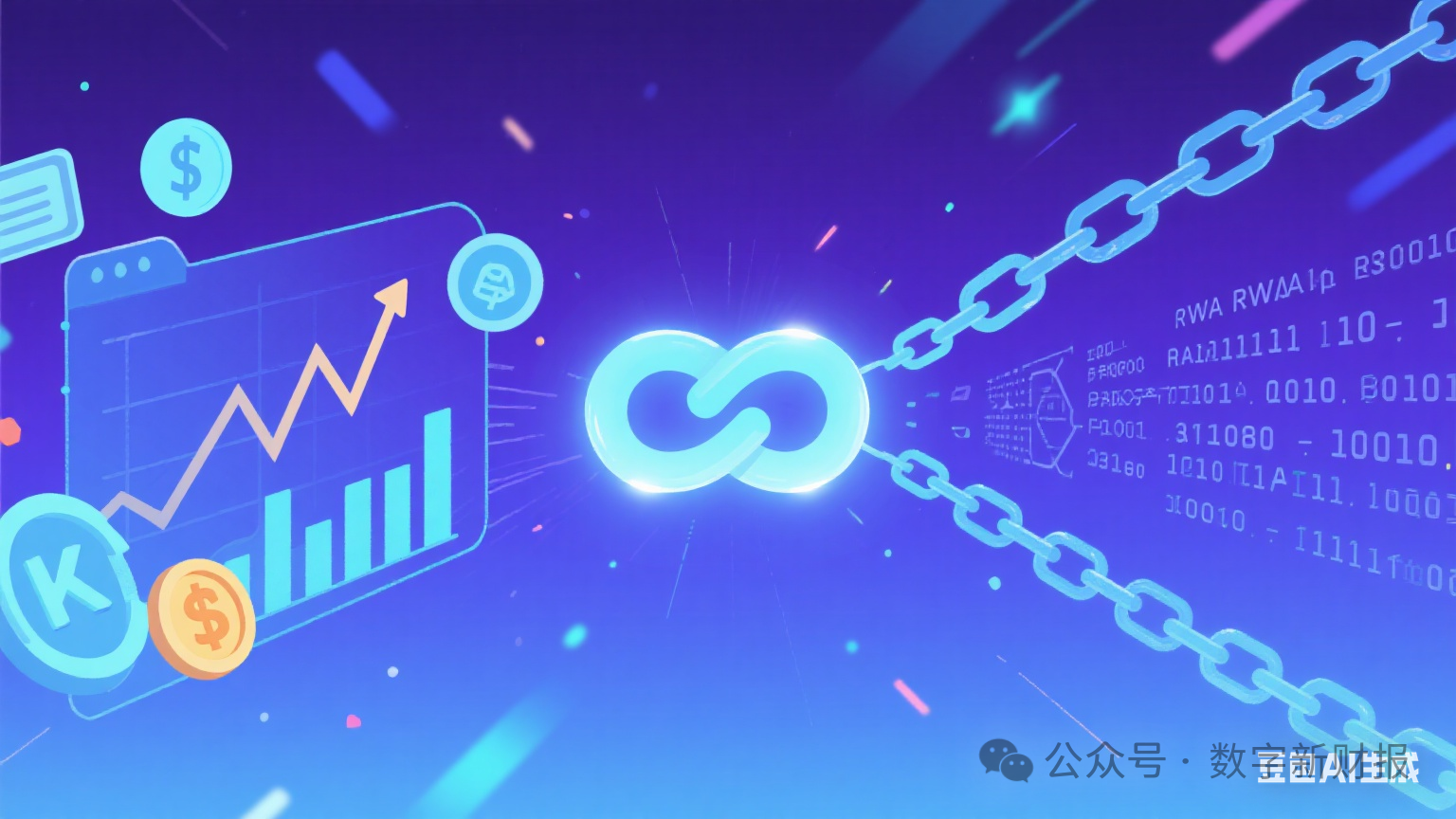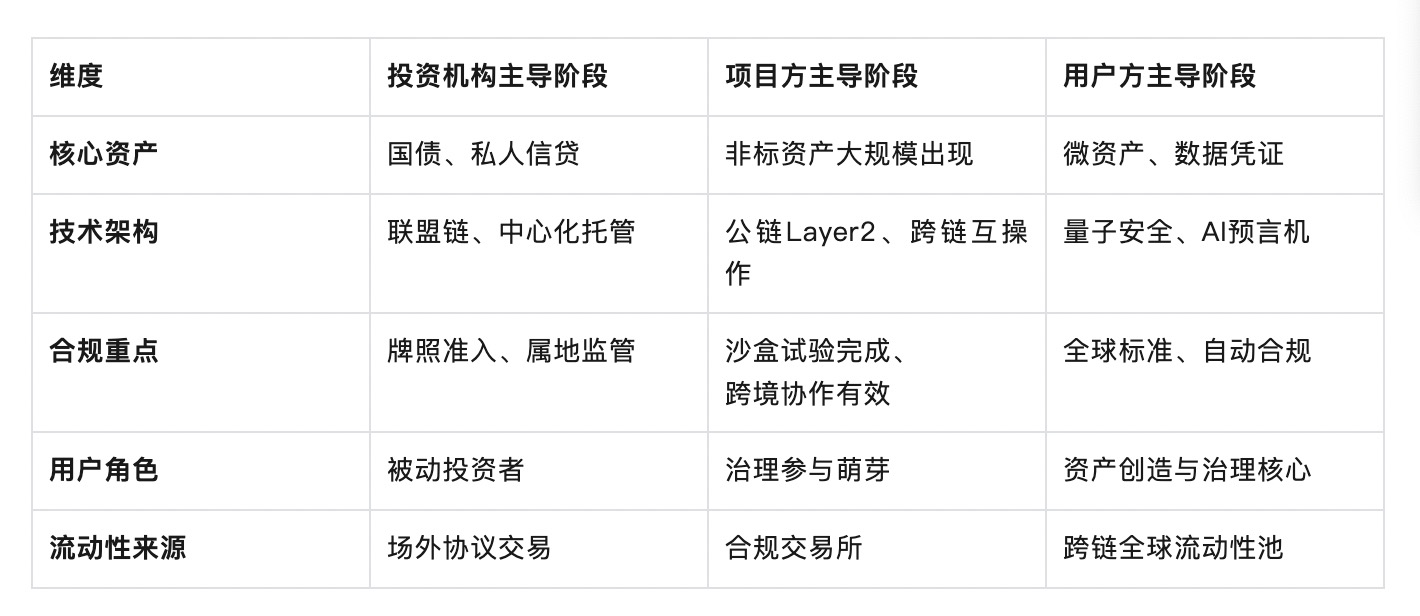Author: Zhang Feng
I. RWA May Present a Three-Stage Evolution Pattern
The diverse attributes of RWA, including financial, technological, and industrial aspects, successively become the core driving forces of each stage, pushing the dominance from the capital side to the technology side and finally to the demand side, with a clear path; at the same time, each stage exhibits systematic differences in asset forms, technical architecture, compliance frameworks, and user rights. Therefore, we believe that in terms of development paths, RWA projects and ecosystem development will undergo a clear three-stage evolution—transitioning from the current investment institution-led stage to the project party-led stage, and finally moving towards the user party-led stage.

The financial, technological, and industrial triad attributes of RWA jointly determine the three-stage developmental path of "investment institutions—project parties—user parties."
In the initial stage, financial attributes are the strongest. RWA requires compliant pricing, rating, and liquidity, with investment institutions leveraging their funding and licensing advantages to complete asset tokenization and market-making first, forming market benchmarks.
Subsequently, technological attributes become prominent. Project parties gradually have the motivation for proactive technological transformation, mastering infrastructure such as chain reform, oracle, and programmable contracts, enabling more physical assets to be efficiently tokenized and embedded in DeFi, reducing issuance costs and expanding supply.
Finally, industrial momentum is released. When the scale and returns of on-chain assets are sufficiently large and the usage threshold is low enough, end users can directly hold, trade, or mortgage RWA to obtain returns, achieving "everyone is an asset operator."
II. Investment Institution-Led Stage
Currently, the RWA ecosystem is dominated by traditional financial institutions and professional investment institutions, characterized by high thresholds, strong regulation, and heavy reliance on credit, with the core focus on solving the liquidity dilemma of non-standard assets and the issue of credit transmission.
(1) Asset Characteristics: Primarily High Liquidity Financial Assets
Private credit dominates. Globally, the scale reaches billions of dollars, mainly consisting of corporate loans issued by platforms like Figure and Tradable, with an average annual interest rate of 9.74%, serving small and medium-sized enterprises that cannot obtain financing from traditional banks.
Tokenization of government bonds is rapidly rising. Represented by BlackRock's BUIDL fund, with a scale of $2.41 billion, backed by a portfolio of U.S. government bonds, supporting redemption in USD or USDC stablecoins, becoming a "risk-free yield anchor" in the DeFi ecosystem.
Initial attempts at non-standard assets. For example, Hong Kong's Delin Holdings tokenized commercial properties in Central (valued at HKD 280 million), but it requires professional investor qualifications and has limited liquidity.
(2) Technical Characteristics: Coexistence of Consortium Chains and Centralized Custody
Consortium chains dominate asset tokenization. Platforms like R3 Corda, Hyperledger Fabric, and domestic Ant Chain are preferred by financial institutions due to controllable node access and compliance with KYC requirements.
Off-chain assets heavily rely on oracles. Physical gold (PAXG) and real estate require verification by licensed institutions, with data fed through oracles to map to on-chain tokens.
Smart contract functions are singular. Focused on basic issuance and dividends, such as BUIDL's automatic interest calculation function, complex governance still relies on centralized SPVs.
(3) Compliance Requirements: Licensing and Localized Regulation
Hong Kong promotes a sandbox system. The RWA regulatory sandbox, starting in 2024, is continuously improving, while the "Stablecoin Regulation" effective in August 2025 requires stablecoin issuers to be licensed, and security tokens need SFC case-by-case approval.
The U.S. clarifies securities attributes. The SEC includes most RWAs within the securities framework, requiring compliance with Reg D/S exemption clauses, with financing limits constrained by Regulation CF.
High cross-border compliance costs. Cross-border projects must meet the requirements of multiple jurisdictions, such as Hong Kong's "Securities and Futures Ordinance" and Cayman SPV structures, which can be time-consuming.
(4) User Rights: Priority for Professional Investors
High thresholds exclude retail investors. Most RWA project tokens are only allocated to "professional investors," requiring KYC certification and proof of assets of HKD 1 million.
Rights to returns outweigh governance rights. BUIDL holders can earn interest, but have no rights to participate in asset strategy adjustments.
Exits rely on centralized redemption. Redemption in USD on the Securitize platform requires T+2 settlement, limiting liquidity.
III. Project Party-Led Stage
As technology matures and regulatory sandboxes are promoted, physical enterprises and technology platforms gradually recognize the advantages of RWA, becoming motivated to increase technological content, build internal and external trust, and open up ecosystem development, thus becoming core drivers, with the goal of revitalizing their asset liquidity and expanding financing channels.
(1) Asset Characteristics: Large-Scale Tokenization of Physical Assets
Non-standard assets begin to become mainstream. In addition to supply chain finance (accounts receivable, orders) and new energy assets (photovoltaic power plants), high-value assets such as intellectual property, cultural creativity, and other industries are entering the market.
Fragmented investment begins to proliferate. The tokenization threshold for real estate has dropped to $50 per share, as seen in the U.S. RealT project, which supports retail investors in investing in properties and receiving rental income in stablecoins.
Stablecoins become pricing hubs. Platforms like RWA Group support multi-chain stablecoin (USD/RMB/HKD) settlements, facilitating cross-border payments.
(2) Technical Characteristics: Layer 2 Public Chains and Cross-Chain Breakthroughs
Layer 2 essentially resolves performance bottlenecks. For example, future low-Gas fee chains like Polygon support 24/7 trading, reducing the settlement cycle from T+2 to seconds, improving efficiency by 90%.
Dynamic compliance begins to be embedded in smart contracts. For instance, the Rtree platform verifies investor qualifications through zero-knowledge proofs, automatically executing KYC rules across different legal jurisdictions.
Off-chain assets and on-chain tokens begin to anchor each other bidirectionally. For example, the gold token PAXG is pegged 1:1 to physical gold in LBMA vaults, with IoT sensors monitoring asset status in real-time.
(3) Compliance Requirements: Mutual Recognition of Regulatory Frameworks and Sandbox Innovations
Hong Kong's LEAP framework is basically implemented. Promoting mutual recognition of securities and commodity tokens, allowing cross-border trading.
EU MiCA regulations are basically integrated. STOs (security tokens) can circulate in member states, with Robinhood's European stock tokens subject to MiFID II regulation.
Sandboxes further promote compliance testing. The Hong Kong Ensemble sandbox tests hybrid models such as NFT art + revenue sharing.
(4) User Rights: Emergence of Governance Participation
DAO governance begins preliminary operations. Platforms start to create dedicated DAOs for RWA, allowing token holders to vote on asset disposal strategies.
On-chain returns begin real-time distribution. Rental income and interest are automatically distributed through smart contracts, avoiding delays typical in traditional finance.
Liquidity mechanisms gradually improve. Compliance exchanges are beginning to be accessed, and some DeFi pools are opening up liquidity provision to retail investors.
IV. User Party-Led Stage
When the underlying infrastructure of RWA is complete, data utilization capabilities and efficiency will significantly improve, with individual users and communities becoming the center of the ecosystem, achieving the assetization of user data rights and decentralization of governance.
(1) Asset Characteristics: Tokenization of Personal Assets and Data Certificates
Micro-asset certificates begin to go on-chain. Personal carbon credits, social media data, and creative copyrights are circulating on-chain.
User-Generated RWA (UG-RWA) begins to gain popularity. For example, tokenization of cross-border trade certificates + DeFi lending allows individuals to issue assets based on order revenue rights.
Cross-chain global liquidity pools are gradually forming. Cross-chain exchanges of gold, real estate, and government bond tokens are approaching zero friction costs.
(2) Technical Characteristics: Quantum Security and AI-Driven DAOs
Quantum encryption technology begins to ensure security. National Wealth Quantum and others are developing quantum random number wallets to defend against quantum computing attacks.
AI oracles for dynamic pricing begin to operate. Replacing traditional assessment agencies, they analyze the value fluctuations of non-standard assets in real-time.
Fully automated governance engines operate. DAO proposals, voting, and execution are completed entirely on-chain, such as the Matrix system realizing "code is law."
(3) Compliance Requirements: Global Unified Standards
RWA identity passports are gradually maturing. On-chain KYC certificates are universally applicable across platforms, meeting multiple legal jurisdiction requirements.
Automatic tax compliance operations. Smart contracts automatically withhold capital gains tax based on user nationality.
(4) User Rights: Data Sovereignty and Governance Core
Data revenue rights are confirmed. User behavior data, once tokenized, can be traded or mortgaged for loans.
Decentralized governance begins to mature. Voting weight of token holders determines asset strategies, such as whether to issue more, liquidate, or collaborate across sectors.
User-led asset creation begins to operate. Individuals can issue "order revenue rights certificates," forming a UG-RWA (User-Generated Real World Assets) market.
Table: Comparison of RWA Three-Stage Development Characteristics

V. Current Positioning and Future Challenges
Currently, the global RWA ecosystem is clearly at the end of the investment institution-led stage, showing signs of transitioning to the project party-led stage:
Institutional assets still dominate, with private credit and government bonds accounting for 87%, and traditional giants like BlackRock and Figure controlling pricing power.
Technological infrastructure needs to mature, as mature and compliant blockchain issuance infrastructure still requires refinement, and related technical protocols need further enrichment; Hong Kong's Ensemble sandbox may serve as a corresponding demonstration for the industry.
Regulatory systems still need to be constructed and improved, with Hong Kong's "Stablecoin Regulation," the U.S. "GENIUS Act," and the EU MiCA forming a basic framework, but the system construction has not yet formed, and cross-border mutual recognition is still lacking.
However, transitioning to the next stage requires breaking through three bottlenecks:
Technical-compliance closed loop: The legal validity of oracle data needs judicial confirmation, and zero-knowledge proofs must be compatible with GDPR.
Insufficient liquidity depth: Currently, most RWAs rely on over-the-counter trading, and the RWA trading market has yet to reach its expected prosperity.
Rebalancing user rights: Transitioning from "professional investor privileges" to governance rights accessible to retail investors requires reconstructing the legal status of DAOs.
Of course, the above is a general stage division; in reality, representative characteristics of the second and third stages may also begin to be realized in some highly digitized projects in the first stage, while in the second and third stages, there will still be projects driven by institutions, so this is not contradictory. It is merely a question of what type of project is dominant in a given stage.
免责声明:本文章仅代表作者个人观点,不代表本平台的立场和观点。本文章仅供信息分享,不构成对任何人的任何投资建议。用户与作者之间的任何争议,与本平台无关。如网页中刊载的文章或图片涉及侵权,请提供相关的权利证明和身份证明发送邮件到support@aicoin.com,本平台相关工作人员将会进行核查。




